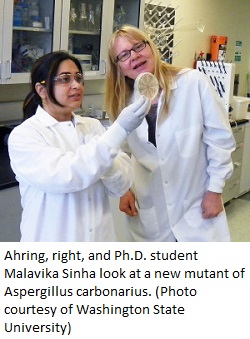Researchers at Washington State University are making a biofuel for jets from a common black fungus found in decaying leaves, soil and rotting fruit. This news release from the school says they hope to have a viable aviation biofuel in the next five years.
 The researchers used Aspergillus carbonarius ITEM 5010 to create hydrocarbons, the chief component of petroleum, similar to those in aviation fuels.
The researchers used Aspergillus carbonarius ITEM 5010 to create hydrocarbons, the chief component of petroleum, similar to those in aviation fuels.
Led by Birgitte Ahring, director and Battelle distinguished professor of the Bioproducts, Sciences and Engineering Laboratory at WSU Tri-cities, the researchers published their work in the April edition of Fungal Biology.
The fungus produced the most hydrocarbons on a diet of oatmeal but also created them by eating wheat straw or the non-edible leftovers from corn production.
Fungi have been of interest for about a decade within biofuels production as the key producer of enzymes necessary for converting biomass to sugars. Some researchers further showed that fungi could create hydrocarbons, but the research was limited to a specific fungus living within a specific tree in the rainforest, and the actual hydrocarbon concentrations were not reported.
Ahring’s group has previously been successful in using standard Aspergillus fungi to produce enzymes and other useful products, which have been patented and are under commercialization, so they decided to look into A. carbonarius ITEM 5010’s potential for biofuels.
The researchers got help from Kenneth Bruno, a researcher at the U.S. Department of Energy’s Pacific Northwest National Laboratory, who developed a method essential for the genetic manipulation of A. carbonarius. The research received funding from the Danish Council for Strategic Research under the program for Energy and Environment.

